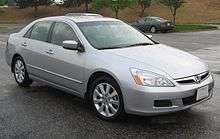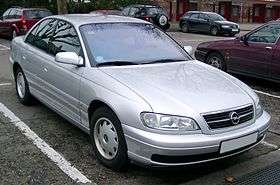Mid-size car

A mid-size car (occasionally referred to as an intermediate) is the North American/Australian standard for an automobile with a size equal to or greater than that of a compact. In Europe mid-sizers are referred to as D-segment or large family cars.
United States

The automobile that defined this size in the United States was the Rambler Six that was introduced in 1956, although it was called "compact" car at that time.[1] The mid-size class then grew out of the compacts of the early-1960s. For example, the Ford Fairlane was referred to at its introduction in 1962 as a compact intermediate because it was barely bigger than its close relative, the Falcon. General Motors' first entries in the class, such as the Oldsmobile F-85, Pontiac Tempest, and Buick Special were not mechanically related to the compact Chevrolet Corvair, but were similar in size.
At that time vehicle classes were defined more by their wheelbase than interior passenger space and cargo capacity. The class began to grow rapidly, and for the next ten years each expansion in size in the full-size field was followed by a proportionate growth in the mid-size models. By the mid-1960s, they were as big as the full-size cars of the mid-1950s. By the mid-1970s, they were nearly as big as the full-size cars of the mid-1960s.

During the 1970s, the intermediate class was generally defined as vehicles with wheelbases between 112 inches (2,845 mm) and 118 inches (2,997 mm). A turning point occurred in the late 1970s, when rising fuel costs and government fuel economy regulations caused all car classes to shrink, and in many cases to blur. Automakers moved previously "full-size" nameplates to smaller platforms.[2] New "official" size designations in the U.S. were introduced by the EPA, which defined market segments by passenger and cargo space.[3] Formerly mid-sized cars that were built on the same platform, like the AMC Matador sedan, had a combined passenger and cargo volume of 130 cubic feet (3.68 m3), and were now considered "full-size" automobiles.[4]
The situation was complicated when General Motors began to downsize its models about two years before everybody else. In 1978, the Chevrolet Malibu nameplate had been redesigned on a 108-inch (2,743 mm) wheelbase, while the Ford Granada moved to the 105-inch (2,667 mm) wheelbase of the Ford Fairmont's Fox platform in 1981. Both competed with the Chrysler standard and extended K-cars, often classified as compact, though mid-size by EPA standards. Former mid-size platforms such as the Plymouth Satellite would be rebranded as full-size, rebodied, or dropped in the face of the downsized Chevrolet Caprice. Some were subsequently replaced by what used to be large compacts, like the Plymouth Gran Fury in police applications. The Granada would be badged with the (formerly full-size) LTD moniker before being replaced by the class-defining Ford Taurus. Similarly, import models such as the Honda Accord and Toyota Camry that had been classified by the EPA as compact in 1985 grew to the mid-size class by the 1990s. The Accord later grew even larger; its eighth North American sedan version was classified by the EPA as a full-size car, although its coupe version remained in the mid-size class. The current ninth generation North American sedan was slightly smaller than its immediate predecessor, putting it once again in the mid-size class.
Mid-size vehicles today usually have wheelbases between 105 inches (2,667 mm) and 110 inches (2,794 mm). Another widely used definition is that of the EPA, which classifies cars between 110 cubic feet (3.11 m3) and 119 cubic feet (3.37 m3) of interior volume as mid-size.
Mid-size cars are the most popular category of cars sold in the United States, with 27.4 percent in the first half of 2012 ahead of crossovers at 19 percent.[5]

Japan
In Japan, the term mid-size car probably does not have the intermediate sense that it does in other markets. Due to space restrictions, the range of cars available in this market starts from a much smaller size. As such, the models that Japan exports to other markets to compete in mid-size market segments such as the Mazda 6, Subaru Legacy, Toyota Mark X, Nissan Teana and Honda Inspire occupy a more exclusive segment in the Japanese marketplace.
An interesting quirk of the Japanese automotive tax codes is that width is one of factors determining under which category a car is taxed. The standards state any vehicles more than 4.7 m (15.4 ft) long, 1.7 m (5.6 ft) wide, 2 m (6.6 ft) high, or with engines larger than 2000 cc are what is called "passenger size vehicles". This regulation also mandates that all passenger vehicles cannot exceed 5 m (16.4 ft) length or 1.8 m (5.9 ft) in width. Therefore, even mid-size cars destined for export markets from Japan had widths less than 1,700 mm (66.9 in), as manufacturers had to look to domestic consumption, as well as export. However, as export markets have become progressively more significant for Japanese car manufacturers, more models have been produced that break this 1700-mm-wide limit.
See also
References
- ↑ Auto Editors of Consumer Guide (5 September 2007). "1956-1957 Rambler". Retrieved 24 December 2012.
- ↑ Dunne, Jim (September 1975). "Detroit Report: an intermediate step". Popular Science 207 (3): 40. Retrieved 24 December 2012.
- ↑ "How are vehicle size classes defined?". fueleconomy.gov. Retrieved 24 December 2012.
- ↑ "1978 49-state Fuel Economy Guide". fueleconomy.gov. 10 November 1978. Retrieved 24 December 2012.
- ↑ St. Antoine, Arthur (December 2012). "Comparison: 2012-2013 Midsize Sedan Comparison: Battle of the Best-Sellers". Motor Trend. Retrieved 24 December 2012.
External links
United States Environmental Protection Agency lists of midsize cars